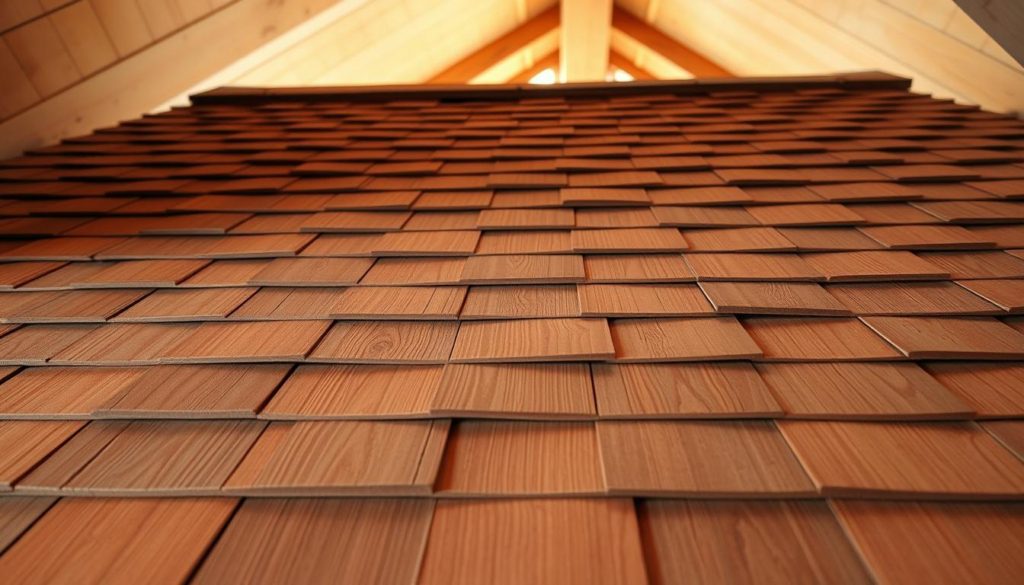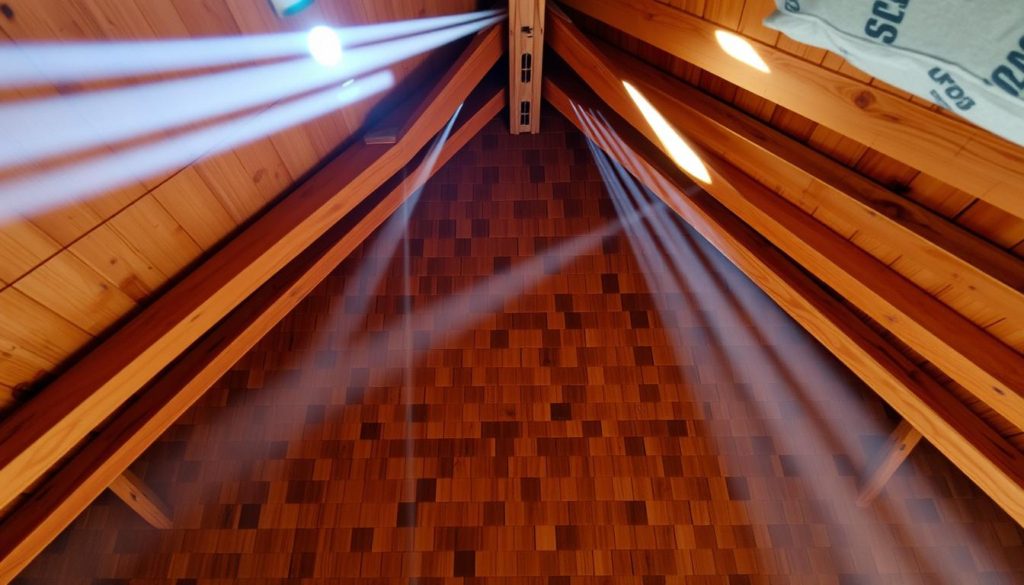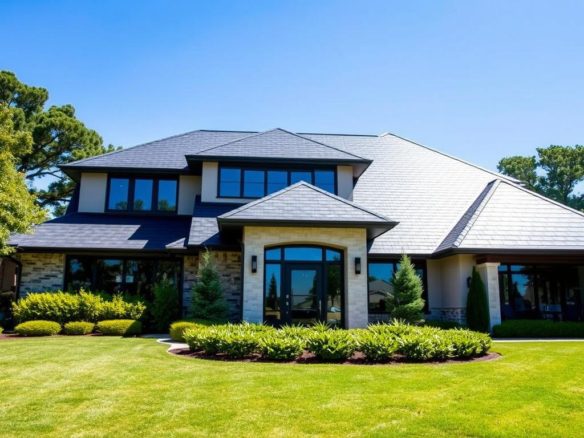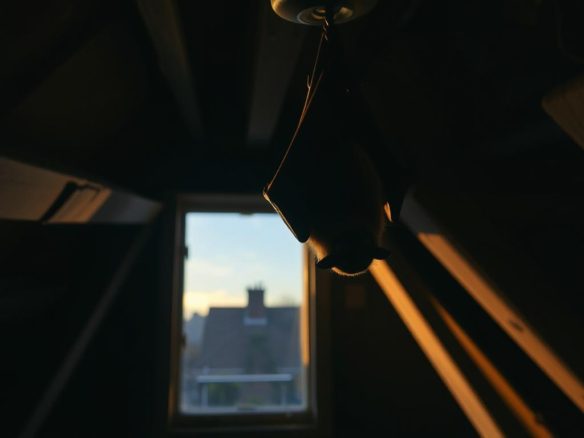Many homeowners in the United States don’t know what roofing material they have. This can cause expensive repairs and maintenance problems. Knowing how to spot cedar shake roofing from the attic is key to keeping your roof in top shape.
Regular checks are important to keep cedar shake roofs in good condition. This article will show you how to spot cedar shake roofing from the attic. It will highlight its unique features and signs of wear. By learning to identify cedar shake roofing, you can take care of your roof and avoid expensive fixes.
Knowing how to identify cedar shake roofing from the attic is very helpful. It lets you catch problems early and fix them before they get worse. By understanding cedar shake roofing and how to spot it from the attic, you can keep your roof in great shape for a long time. Spotting cedar shake roofing from the attic is a key step in keeping your roof strong and avoiding costly repairs.
Key Takeaways
- Identifying cedar shake on a roof from attic is crucial for maintaining the roof’s integrity and extending its lifespan.
- Regular inspections are vital to ensure cedar shake roofs remain in good condition.
- Learning how to identify cedar shake on a roof from attic requires attention to detail and knowledge of the roofing material’s characteristics.
- Homeowners can benefit from learning how to identify cedar shake roofing from attic to address potential issues before they become major problems.
- Understanding the basics of cedar shake roofing is essential for identifying it from the attic.
- Identifying cedar shake roofing from attic helps prevent costly repairs and maintains the roof’s integrity.
Understanding Cedar Shake Roofing Basics
Cedar shake roofing is loved for its natural look and lasting quality. Spotting cedar shake roofing from inside is key. Knowing how to spot it from the attic helps homeowners keep their roof in top shape.
Cedar shake shingles are made from western red cedar. This wood fights off rot and bugs well. From the attic, look for the unique texture and how the shingles overlap. This helps protect against weather.
What are Cedar Shake Shingles?
Cedar shake shingles are made from natural cedar wood. They last long and resist rot and bugs. Plus, they don’t warp or crack easily, making them a favorite among homeowners.
Common Characteristics of Cedar Shake Roofs
Cedar shake roofs have a few key traits:
- Distinctive texture
- Overlapping shingles
- Natural resistance to rot and insect damage
- Resistance to warping and cracking
Why Identifying from the Attic Matters
Spotting cedar shake roofing from the attic is important. It lets homeowners find and fix problems early. This can save the roof and avoid expensive fixes.
Essential Safety Precautions for Attic Inspection
When detecting cedar shake shingles from attic, safety is key to avoid injuries. Before you start, wear protective gear, have good lighting, and watch out for weak spots in the attic.
Here are some safety tips for a safe inspection:
- Wear protective clothing, including a dust mask, gloves, and safety glasses
- Use a sturdy ladder and make sure it’s stable
- Look for hazards like insulation, electrical wiring, and sharp objects in the attic
When distinguishing cedar shake on a roof from interior view, be careful of your surroundings. Also, remember the attic needs good ventilation and light for a safe check.
By following these safety steps, you can have a safe attic check. This lets you spot cedar shake roofing and make smart choices for upkeep and fixes.
Required Tools and Equipment for Identification
To spot cedar shake roofing from the top, you need the right tools. A good inspection from above requires the right gear. You’ll need both basic and advanced tools to identify a cedar shake roof.
Start with basic tools like a flashlight, gloves, and safety glasses. These are key for a safe and thorough check. You might also want a ladder, a roof camera, or a drone for a better view.
Basic Tools Needed
- Flashlight
- Gloves
- Safety glasses
Optional Advanced Equipment
- Ladder
- Roof inspection camera
- Drone
Good lighting is also important. You might need extra lights for dark attic spots. With the right tools, you can safely and accurately check your roof.
Lighting Requirements
Good lighting is key for spotting cedar shake roofing from above. Use strong flashlights or extra lights to see clearly.
How to Identify Cedar Shake on a Roof from Attic: Step-by-Step Guide
To start recognizing cedar shake roofing from inside the house, first find the attic access point. Make sure it’s safe to enter. Inside, look for signs of cedar shake shingles, like their unique texture and color.
Next, inspect the roof’s condition and check for signs of wear. Document any findings, including photos and notes.
When how to identify cedar shake on a roof from attic, consider the following steps:
- Check the attic for any signs of water damage or leaks
- Look for the distinctive texture and color of cedar shake shingles
- Inspect the roof’s condition, checking for signs of deterioration
- Document any findings, including photos and notes
By following these steps, homeowners can effectively identify cedar shake roofing from the attic. This helps them assess their roof’s condition and make informed decisions about maintenance and repairs.
| Signs of Cedar Shake Roofing | Description |
|---|---|
| Distinctive Texture | Cedar shake shingles have a unique, rough texture |
| Color | Cedar shake shingles typically have a warm, brown color |
| Water Damage | Look for signs of water damage or leaks in the attic |
By recognizing cedar shake roofing from inside the house and following these steps, homeowners can ensure their roof remains in good condition. They can make informed decisions about maintenance and repairs.
Visual Indicators from the Attic Interior
When you check the attic, look for signs of cedar shake roofing. You can spot cedar shake by the sheathing patterns, where nails are placed, and the wood grain. Knowing these signs helps you identify cedar shake shingles from inside the attic.
Sheathing Patterns
Cedar shake shingles have a unique pattern of overlapping. This pattern is easy to see from the attic. It’s a big clue that you have cedar shake roofing. The patterns can change based on the type of shingles, but often they’re staggered or offset.
Nail Positioning
The nails holding cedar shake shingles are usually seen from the attic. Looking at where the nails are placed can tell you about the roof’s state and the shingles. Evenly spaced nails at a consistent angle suggest a well-done job.
Wood Grain Visibility
The wood grain of cedar shake shingles is also visible from the attic. It tells you a lot about the roof. The grain can show the cedar type, shingle age, and wear. By looking at the grain, you can understand your roof better and plan for upkeep or repairs.
| Visual Indicator | Description |
|---|---|
| Sheathing Patterns | Distinctive pattern of overlapping shingles |
| Nail Positioning | Nails spaced evenly and driven into the sheathing at a consistent angle |
| Wood Grain Visibility | Wood grain visible from the attic, providing information about the roof’s condition |
Distinguishing Between Cedar Shake and Other Roofing Materials
When detecting cedar shake shingles from attic, it’s key to tell them apart from other roofing types. Cedar shake roofing stands out with its texture, color, and pattern. It’s different from asphalt shingles or clay tiles.
To spot cedar shake roofing, look for these signs:
- Natural wood grain visibility
- Distinctive texture and pattern
- Warm, earthy color tones
By distinguishing cedar shake on a roof from interior view, homeowners can make sure they’re right. Knowing the difference helps in deciding on maintenance and repairs. It’s important to avoid confusing cedar shake with other materials.

In summary, telling cedar shake apart from other roofing materials needs careful observation and knowledge. By following these tips, homeowners can correctly identify their roof. This helps in keeping it in good shape and fixing any issues.
| Roofing Material | Characteristics |
|---|---|
| Cedar Shake | Natural wood grain, distinctive texture and pattern, warm color tones |
| Asphalt Shingles | Uniform texture, variety of colors, affordable |
| Clay Tiles | Durable, fire-resistant, distinctive curved shape |
Common Signs of Cedar Shake Deterioration from Inside
When looking at your roof from upstairs, it’s key to spot signs of wear. Finding cedar shake shingles from above can be tricky. Yet, there are clear signs to watch for. Knowing these can help you keep your roof in good shape.
Water Damage Indicators
Water damage shows up as stains, warping, or rotting on the shingles. Check your attic often for water damage signs. This can stop your cedar shake roof from getting worse.
Aging Signs
As shingles age, they might fade, crack, or curl. These signs are small but important. They tell you if your roof needs fixing or a new one.
Ventilation Issues
Bad ventilation can make your roof deteriorate faster. Make sure your attic has good airflow to avoid moisture. Good ventilation helps your roof last longer.
Knowing these signs helps you take care of your roof. Regular checks and upkeep can catch problems early. This keeps your roof strong and saves you money on repairs.
Best Times for Attic Inspection
Timing is key when checking your attic for cedar shake roofing. Look for dry, sunny days for the best results. Natural light helps a lot, so pick a time when it’s not too harsh.
For clear views, aim for mornings or afternoons. This way, you won’t strain your eyes. Stay away from extreme weather like heavy rain or intense heat. It’s safer and easier to move around.
When planning your attic check, keep these points in mind:
- Weather conditions: Avoid extreme weather, such as heavy rain or intense heat.
- Daylight: Natural light can be beneficial for inspections, so consider the time of day.
- Personal convenience: Choose a time that works for you and allows for a thorough inspection.
By planning well, you can safely and effectively check your cedar shake roofing. Always put your safety first and be careful in the attic.
Troubleshooting Identification Challenges
Identifying cedar shake roofing from the attic can be tough. Homeowners might face issues like not being able to see well or insulation getting in the way. To solve these problems, it’s key to use the right tools and methods. Spotting cedar shake from inside can be tricky, but with the right steps, you can do a complete check.
Common problems include not being able to reach some spots and insulation blocking your view. To tackle these, think about using special gear like cameras or drones for hard spots. Also, taking out insulation or using special tools can help you get around obstacles and do a full check.
Overcoming Limited Visibility
To deal with not being able to see well, try these tips:
- Use a flashlight or a lamp to light up the area
- Take out insulation to get a better look
- Use a camera or a drone to check out hard-to-reach spots
Dealing with Insulation Obstacles
To handle insulation getting in the way, try these tips:
- Use a special tool to get through the insulation
- Remove the insulation to get a better view
- Use a camera or a drone to see the area from another angle

By following these tips and using the right tools, you can beat the challenges and do a thorough check of your cedar shake roofing from the attic. Always put your safety first and think about getting a pro if you’re not sure about anything.
| Challenge | Solution |
|---|---|
| Limited Visibility | Use a flashlight or a lamp, remove insulation, or use a camera or a drone |
| Insulation Obstacles | Use a specialized tool, remove the insulation, or use a camera or a drone |
When to Consult a Professional
Homeowners can check their attic for cedar shake roofing. But, there are times when you need a pro. Spotting cedar shake shingles from the attic needs a close look. It’s hard to tell from inside.
If your roof looks bad or you see a lot of damage, get help. Look for experts who know about cedar shake roofing. They can give you the right advice and fix things right.
Some signs you need a pro include complex repairs or doubts about your roof. Also, if you see a lot of wear and tear. Find someone with experience and the right qualifications.
- Experience with cedar shake roofing
- Qualifications and certifications
- Insurance and liability coverage
- Reputation and customer reviews
Getting a pro to check your roof is smart. They can make sure it lasts longer and avoid expensive fixes. Remember, checking your roof from the attic needs skill. So, don’t be afraid to ask for help.
If you’re not sure, it’s better to be safe and get a pro. This keeps your roof safe and saves you money in the long run. It also gives you peace of mind.
Documentation and Maintenance Tips
After checking the attic, it’s key to document what you find. This includes photos, notes, and any repair or maintenance suggestions. This record helps homeowners keep an eye on their roof’s health and spot problems early. When identifying cedar shake roof from upper level, look for signs of wear like cracked or missing shingles.
To keep the roof in shape, homeowners should focus on cleaning, inspecting, and fixing it when needed. Here are some tips for maintenance:
- Regularly inspect the roof for signs of damage or deterioration
- Clean the roof to remove debris and dirt
- Repair or replace damaged or missing shingles
By following these tips, homeowners can make their cedar shake roofing last longer. When spotting cedar shake shingles from above, look for their unique texture and pattern. Regular upkeep is key to avoiding damage and keeping the roof in top shape.
Conclusion
Identifying cedar shake roofing from the attic is key to keeping your roof in good shape. By following the steps in this guide, homeowners can spot the unique signs of cedar shake. This helps them fix problems early and avoid bigger issues later.
Regular checks and care are vital to make your cedar shake roof last longer. This material is not only strong but also looks great. Knowing how to spot cedar shake from inside helps homeowners catch issues before they get worse.
This way, they can keep their home looking beautiful and valuable for many years. With the right care, cedar shake roofing can be a great choice for your home for decades.
FAQ
What are Cedar Shake Shingles?
Cedar shake shingles are made from western red cedar. They resist rot and insects well. Their unique texture and pattern make them stand out.
Why is identifying cedar shake roofing from the attic important?
Checking the attic for cedar shake roofing is key. It lets homeowners see the roof’s state without risking a dangerous climb. This helps keep the roof in good shape longer.
What safety precautions should I take when inspecting the attic?
Safety first when checking the attic. Wear protective gear and use good lighting. Be careful of weak spots and hazards like wiring and sharp objects.
What tools and equipment are needed to identify cedar shake roofing from the attic?
You’ll need basic tools like a flashlight, gloves, and safety glasses. You might also use a ladder, camera, or drone. Good lighting is crucial for a detailed look.
How can I identify cedar shake roofing from the attic?
Start by finding the attic entrance and making sure it’s safe. Look for cedar shake signs like texture and color. Then, check the roof’s condition and document any damage.
What visual indicators should I look for when inspecting the attic for cedar shake roofing?
Look for patterns, nail placement, and wood grain. Cedar shake shingles have a unique pattern and visible nails. The wood grain can also hint at the roof’s state.
How can I distinguish between cedar shake and other roofing materials?
Cedar shake has a distinct texture, color, and pattern. Knowing these differences helps spot it among other materials like asphalt or clay tiles.
What are the common signs of cedar shake deterioration that I can identify from the attic?
Look for water damage, aging signs, and ventilation problems. Water damage shows as stains or rot. Aging can cause fading or cracking. Good ventilation prevents moisture buildup.
When is the best time to inspect my attic for cedar shake roofing?
Inspect during dry, sunny days for better visibility. Consider the time of day for natural light. This makes inspections safer and more effective.
What should I do if I encounter challenges while identifying cedar shake roofing from the attic?
Use cameras or drones for hard-to-reach spots. Remove insulation or use tools to get a full view. This ensures a thorough check.
When should I consult a professional for cedar shake roofing identification and assessment?
If you see extensive damage or are unsure, get a pro. Look for experienced inspectors who know cedar shake roofing well. They can give accurate assessments and repairs.
How should I document and maintain my cedar shake roof after identifying it from the attic?
Document your findings with photos and notes. Regular maintenance keeps the roof in good shape. Clean, inspect, and repair as needed to extend its life.







Join The Discussion